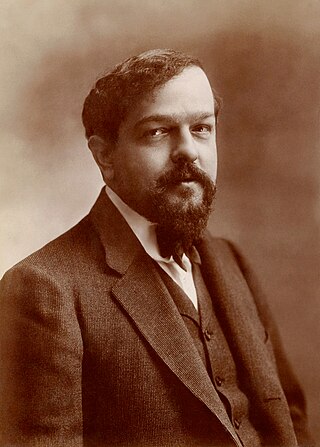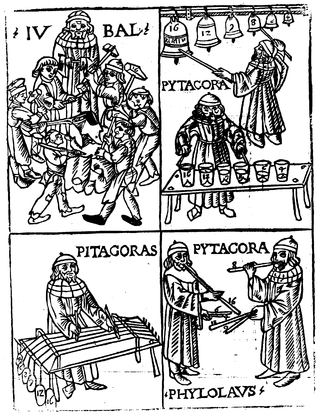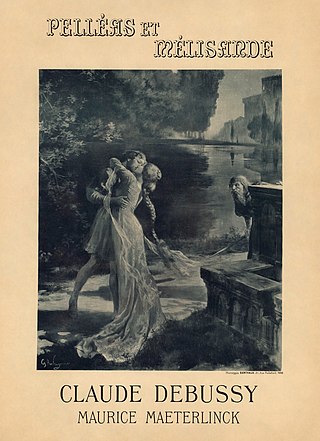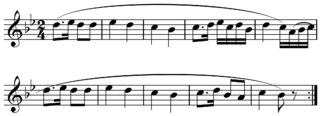
(Achille) Claude Debussy was a French composer. He is sometimes seen as the first Impressionist composer, although he vigorously rejected the term. He was among the most influential composers of the late 19th and early 20th centuries.
A definition of music endeavors to give an accurate and concise explanation of music's basic attributes or essential nature and it involves a process of defining what is meant by the term music. Many authorities have suggested definitions, but defining music turns out to be more difficult than might first be imagined, and there is ongoing debate. A number of explanations start with the notion of music as organized sound, but they also highlight that this is perhaps too broad a definition and cite examples of organized sound that are not defined as music, such as human speech and sounds found in both natural and industrial environments. The problem of defining music is further complicated by the influence of culture in music cognition.

Music theory is the study of the practices and possibilities of music. The Oxford Companion to Music describes three interrelated uses of the term "music theory": The first is the "rudiments", that are needed to understand music notation ; the second is learning scholars' views on music from antiquity to the present; the third is a sub-topic of musicology that "seeks to define processes and general principles in music". The musicological approach to theory differs from music analysis "in that it takes as its starting-point not the individual work or performance but the fundamental materials from which it is built."

Pelléas et Mélisande is an opera in five acts with music by Claude Debussy. The French libretto was adapted from Maurice Maeterlinck's symbolist play of the same name. It premiered at the Salle Favart in Paris by the Opéra-Comique on 30 April 1902; Jean Périer was Pelléas and Mary Garden was Mélisande, conducted by André Messager, who was instrumental in getting the Opéra-Comique to stage the work. The only opera Debussy ever completed, it is considered a landmark in 20th-century music.
In music, texture is how the tempo, melodic, and harmonic materials are combined in a musical composition, determining the overall quality of the sound in a piece. The texture is often described in regard to the density, or thickness, and range, or width, between lowest and highest pitches, in relative terms as well as more specifically distinguished according to the number of voices, or parts, and the relationship between these voices. For example, a thick texture contains many 'layers' of instruments. One of these layers could be a string section or another brass. The thickness also is changed by the amount and the richness of the instruments playing the piece. The thickness varies from light to thick. A piece's texture may be changed by the number and character of parts playing at once, the timbre of the instruments or voices playing these parts and the harmony, tempo, and rhythms used. The types categorized by number and relationship of parts are analyzed and determined through the labeling of primary textural elements: primary melody (PM), secondary melody (SM), parallel supporting melody (PSM), static support (SS), harmonic support (HS), rhythmic support (RS), and harmonic and rhythmic support (HRS).

In music, a motif IPA: (/moʊˈtiːf/) or motive is a short musical idea, a salient recurring figure, musical fragment or succession of notes that has some special importance in or is characteristic of a composition. The motif is the smallest structural unit possessing thematic identity.
Generative music is a term popularized by Brian Eno to describe music that is ever-different and changing, and that is created by a system.
The original Tristan chord is heard in the opening phrase of Richard Wagner's opera Tristan und Isolde as part of the leitmotif relating to Tristan. It is made up of the notes F, B, D♯, and G♯:

In music theory, a phrase is a unit of musical meter that has a complete musical sense of its own, built from figures, motifs, and cells, and combining to form melodies, periods and larger sections.
A phrase is a substantial musical thought, which ends with a musical punctuation called a cadence. Phrases are created in music through an interaction of melody, harmony, and rhythm.

In music, a subject is the material, usually a recognizable melody, upon which part or all of a composition is based. In forms other than the fugue, this may be known as the theme.

In music, modernism is an aesthetic stance underlying the period of change and development in musical language that occurred around the turn of the 20th century, a period of diverse reactions in challenging and reinterpreting older categories of music, innovations that led to new ways of organizing and approaching harmonic, melodic, sonic, and rhythmic aspects of music, and changes in aesthetic worldviews in close relation to the larger identifiable period of modernism in the arts of the time. The operative word most associated with it is "innovation". Its leading feature is a "linguistic plurality", which is to say that no one music genre ever assumed a dominant position.
Inherent within musical modernism is the conviction that music is not a static phenomenon defined by timeless truths and classical principles, but rather something which is intrinsically historical and developmental. While belief in musical progress or in the principle of innovation is not new or unique to modernism, such values are particularly important within modernist aesthetic stances.
In semiotics the neutral level of a sign is the "trace" left behind; the physical or material creation or remains of esthesic and poietic processes, levels, and analyses of symbolic forms. A part of all signs according to a tri-partitional definition, it corresponds to Saussure's "sound-image".
In music theory, prolongation is the process in tonal music through which a pitch, interval, or consonant triad is considered to govern spans of music when not physically sounding. It is a central principle in the music-analytic methodology of Schenkerian analysis, conceived by Austrian theorist Heinrich Schenker. The English term usually translates Schenker's Auskomponierung. According to Fred Lerdahl, "The term 'prolongation' [...] usually means 'composing out' ."
"Cognitive Constraints on Compositional Systems" is an essay by Fred Lerdahl that cites Pierre Boulez's Le Marteau sans maître (1955) as an example of "a huge gap between compositional system and cognized result," though he "could have illustrated just as well with works by Milton Babbitt, Elliott Carter, Luigi Nono, Karlheinz Stockhausen, or Iannis Xenakis". To explain this gap, and in hopes of bridging it, Lerdahl proposes the concept of a musical grammar, "a limited set of rules that can generate indefinitely large sets of musical events and/or their structural descriptions". He divides this further into compositional grammar and listening grammar, the latter being one "more or less unconsciously employed by auditors, that generates mental representations of the music". He divides the former into natural and artificial compositional grammars. While the two have historically been fruitfully mixed, a natural grammar arises spontaneously in a culture while an artificial one is a conscious invention of an individual or group in a culture; the gap can arise only between listening grammar and artificial grammars. To begin to understand the listening grammar, Lerdahl and Ray Jackendoff created a theory of musical cognition, A Generative Theory of Tonal Music. That theory is outlined in the essay.
Music semiology (semiotics) is the study of signs as they pertain to music on a variety of levels.
In music cognition and musical analysis, the study of melodic expectation considers the engagement of the brain's predictive mechanisms in response to music. For example, if the ascending musical partial octave "do-re-mi-fa-sol-la-ti-..." is heard, listeners familiar with Western music will have a strong expectation to hear or provide one more note, "do", to complete the octave.
Psychedelic pop is pop music that contains musical characteristics associated with psychedelic music. Developing in the mid-to-late 1960s, elements included "trippy" features such as fuzz guitars, tape manipulation, backwards recording, sitars, and Beach Boys-style harmonies, wedded to melodic songs with tight song structures. The style lasted into the early 1970s. It has seen revivals in subsequent decades by neo-psychedelic artists.
Carolyn Abbate is an American musicologist, described by the Harvard Gazette as "one of the world’s most accomplished and admired music historians". She is currently Paul and Catherine Buttenwieser University Professor at Harvard University. From her earliest essays she has questioned familiar approaches to well-known works, reaching beyond their printed scores and composer intentions, to explore the particular, physical impact of the medium upon performer and audience alike. Her research focuses primarily on the operatic repertory of the 19th century, offering creative and innovative approaches to understanding these works critically and historically. Some of her more recent work has addressed topics such as film studies and performance studies more generally.
A generative theory of tonal music (GTTM) is a theory of music conceived by American composer and music theorist Fred Lerdahl and American linguist Ray Jackendoff and presented in the 1983 book of the same title. It constitutes a "formal description of the musical intuitions of a listener who is experienced in a musical idiom" with the aim of illuminating the unique human capacity for musical understanding.

Music technology is the study or the use of any device, mechanism, machine or tool by a musician or composer to make or perform music; to compose, notate, playback or record songs or pieces; or to analyze or edit music.










